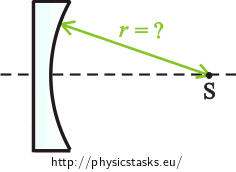A Plano-concave Lens
Task number: 1964
A plano-concave lens made of glass of refractive index of \(1{.}5\) is located in the air. Its focal length is \(−10 \mathrm{cm}\). Determine its radius of curvature.

Notation
\(n_{g}=1{.}5\) refractive index of glass \(f=10 \mathrm{cm}\) focal length \(r= ?\) radius of curvature Hint 1
Each lens has two radii of curvature. Why are we looking only for the value of one of them in this case?
Solution of Hint 1
We already know the value of the radius of curvature \(r_{1}\) of the plane (first) surface because it is approaching infinity. That is why we are only looking for the radius of curvature of the concave (second) surface \(r_{2}=r\).
Hint 2
Let us assume that it is a thin lens. The radii of curvature affect the focal length of the lens. Could you describe this fact mathematically?
Hint 3
How should we adjust the lensmaker’s equation, so that the focal length depends on only the one radius of curvature \(r_{2}=r\)? Then express this radius and calculate it.
Overall Solution
The lensmaker’s equation for a thin lens
Change in the focal length of the lens \(f\) in dependence on the changes in the radii of curvature of optical surface \(r_{1}\) and \(r_{2}\) is defined by the lensmaker’s equation. Let’s assume that we have a thin lens: \[\frac{1}{f}=\left(\frac{n_{g}}{n_{a}}−1\right)\left(\frac{1}{r_{1}}+\frac{1}{r_{2}}\right),\] where \(n_{g}\) is the refractive index of glass and \(n_{a}\) is the refractive index of air.
Expressing the radius of curvature
Radius of curvature \(r_{1}\) is approaching infinity, which means that fraction \(\frac{1}{r_{1}}\) is approaching zero. Therefore, this fraction will „disappear“ from the equation:
\[\frac{1}{f}=\left(\frac{n_{g}}{n_{a}}−1\right)\frac{1}{r_{2}}.\]
Denote radius of curvature \(r_{2}\) by \(r\) (\(r_{2}=r\)):
\[\frac{1}{f}=\left(\frac{n_{g}}{n_{a}}−1\right)\frac{1}{r}.\]
Multiply both sides of the equation by \(r\cdot f\): \[r=\left(\frac{n_{g}}{n_{a}}−1\right)f.\]
Numerical solution
We know from the task assignment:
\(n_{g}=1{.}5\) (refractive index of glass)
\(f=−10 \mathrm{cm}\) (focal length of the lens)
We look up the value of the refractive index of air in the Tables:
\(n_{a}=1{.}0\)
We substitute for the values:
\(r=\left(\frac{n_{g}}{n_{a}}−1\right)f=\left(\frac{1{.}5}{1{.}0}−1\right)\cdot \left(−10\right) \mathrm{cm}=0{.}5\cdot \left(−10\right) \mathrm{cm}=−5 \mathrm{cm}.\)
It is the radius of curvature of the concave surface, therefore, its value is negative.
Answer
The value of the radius of curvature of the plano-concave lens is \(−5 \mathrm{cm}\).




